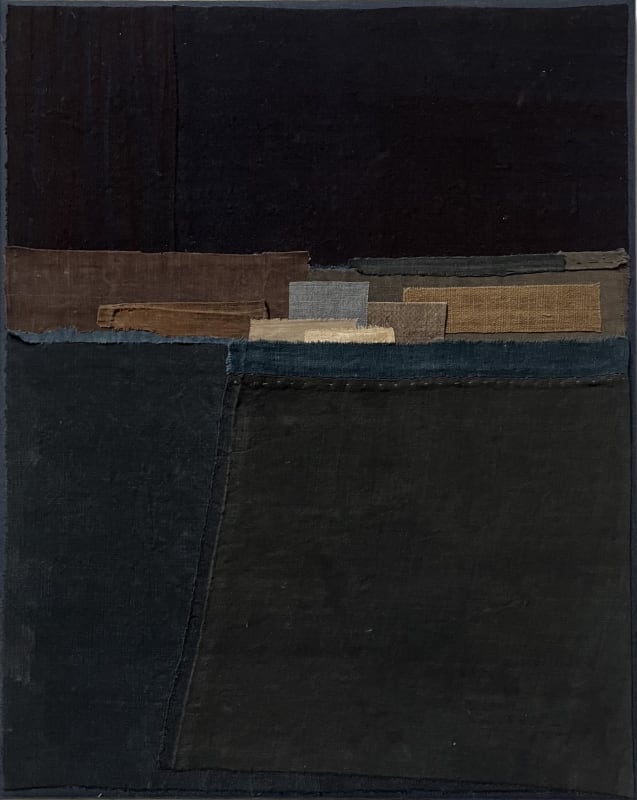Mary Norden has always loved fabrics, especially vintage cloth. Whether printed, woven, threadbare, patched, or plain, each piece comes with a story: a narrative woven into its wear and age, carrying memories of different uses and lives lived. She loves the spontaneity of cutting into a length of fabric, playing with it, creating shapes, adding other colours, just as one would mix paints. She finds it fascinating too how moods and even representative images can be found in these materials. The raw hem of an old red silk slip becomes the horizon in an abstract piece called “First Light”. A vintage Japanese sack originally used for straining unrefined sake, becomes the fields. A new picture always starts with a single piece of fabric. It’s the seed of the picture and where the story begins. It might be the tiniest cotton fragment from a dress, or a strip of old linen, heavy with indigo dye and stains. She then gathers other fabrics that complement the seed fabric, and from here the narrative unfolds, taking her either towards an abstract, sometimes evoking landscape, or a still-life often depicting simple objects. Shapes are built by overlapping layers of fabric, and she likes to incorporate any original stitching – this might be patching, darning, or simple hand stitching, as well as age marks – fading, fold lines, and seam edges.
Her landscape pictures are usually inspired by the different seasons, in particular winter. On winter walks, with no distraction of spring blossom, summer lushness, or autumn color, she thinks a lot about scale and the shape of things – the vastness of the sky over the patchwork of tiny fields, the lone oak in a flooded meadow, and the last of the light on the hill as another day passes.
Finding the ‘seed fabric’ can be challenging and time-consuming, but always opens up endless possibilities. Something that seems unpromising, such as an old French quilt, dirty and worn with age, once unpicked, can reveal layers and layers of fabric, each one older than the last revealing a joyous selection of patterns – plaids, stripes, abstracted florals, sometimes the same pattern but in a different colourway. The innermost layer and she presumes the original cover, can be so worn that it is almost like tissue paper.
For most of her pictures, in particular for the background or the wallpaper in a still life, she looks for rough utilitarian fabrics – hemp, jute, linen, or even a painter’s dust sheet – the more splattered with paint the better. Sometimes she deliberately chooses the reverse side of a printed fabric, preferring the lack of clarity of pattern which adds a little mystery to the picture, or to push the narrative in a different direction by manipulating fabrics with dyes, paint, and bleach. Whether the picture is a composition of tonal subtlety or a more joyous mix of colors, an abstract or a simple still life, they all convey stillness and a quiet moment; another fleeting incident in the life of a piece of fabric.




